Case Study: Nursing Care of a Patient with Septic Shock (NSB236)
VerifiedAdded on 2022/10/17
|11
|3111
|267
Case Study
AI Summary
This case study focuses on the nursing care of a patient, Elodie, experiencing septic shock following treatment for Acute Lymphoblastic Leukemia. The assessment begins by identifying and discussing the patient's decreased saturation and increased heart rate as key signs of clinical deterioration, linking these to the pathophysiology of sepsis. A priority problem of impaired gas perfusion is established, supported by research. The study then details two essential nursing interventions: oxygen therapy and fluid resuscitation, outlining rationales, implementation strategies, and evaluation methods. The nurse's role in monitoring, preventing complications, and ensuring patient safety is emphasized. Finally, a psychosocial issue, the patient's stress and potential depression, is addressed, highlighting the importance of holistic, patient-centered care that includes psychological support for both the patient and their family. The case study underscores the need for evidence-based practice in managing septic shock and improving patient outcomes.
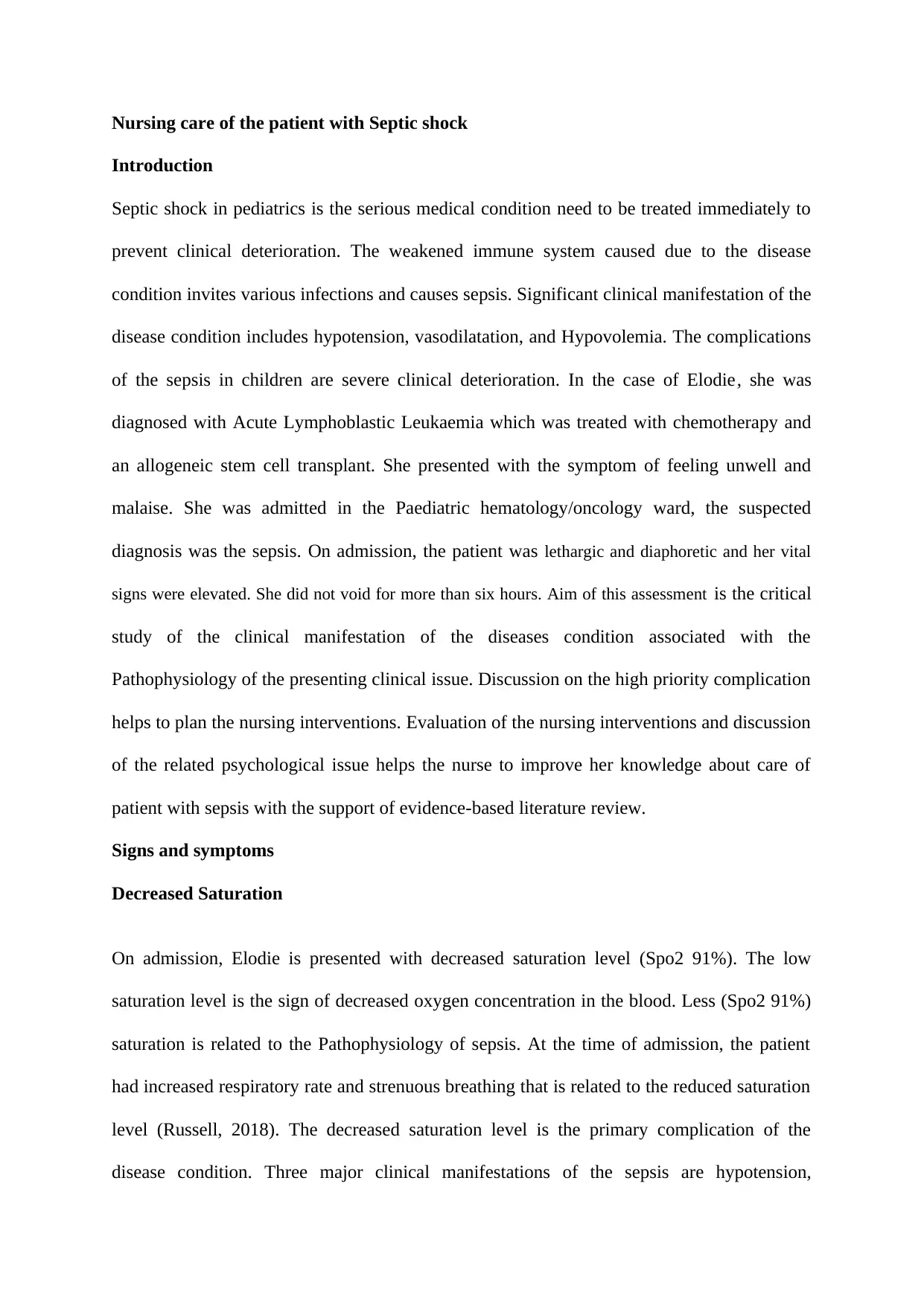
Nursing care of the patient with Septic shock
Introduction
Septic shock in pediatrics is the serious medical condition need to be treated immediately to
prevent clinical deterioration. The weakened immune system caused due to the disease
condition invites various infections and causes sepsis. Significant clinical manifestation of the
disease condition includes hypotension, vasodilatation, and Hypovolemia. The complications
of the sepsis in children are severe clinical deterioration. In the case of Elodie, she was
diagnosed with Acute Lymphoblastic Leukaemia which was treated with chemotherapy and
an allogeneic stem cell transplant. She presented with the symptom of feeling unwell and
malaise. She was admitted in the Paediatric hematology/oncology ward, the suspected
diagnosis was the sepsis. On admission, the patient was lethargic and diaphoretic and her vital
signs were elevated. She did not void for more than six hours. Aim of this assessment is the critical
study of the clinical manifestation of the diseases condition associated with the
Pathophysiology of the presenting clinical issue. Discussion on the high priority complication
helps to plan the nursing interventions. Evaluation of the nursing interventions and discussion
of the related psychological issue helps the nurse to improve her knowledge about care of
patient with sepsis with the support of evidence-based literature review.
Signs and symptoms
Decreased Saturation
On admission, Elodie is presented with decreased saturation level (Spo2 91%). The low
saturation level is the sign of decreased oxygen concentration in the blood. Less (Spo2 91%)
saturation is related to the Pathophysiology of sepsis. At the time of admission, the patient
had increased respiratory rate and strenuous breathing that is related to the reduced saturation
level (Russell, 2018). The decreased saturation level is the primary complication of the
disease condition. Three major clinical manifestations of the sepsis are hypotension,
Introduction
Septic shock in pediatrics is the serious medical condition need to be treated immediately to
prevent clinical deterioration. The weakened immune system caused due to the disease
condition invites various infections and causes sepsis. Significant clinical manifestation of the
disease condition includes hypotension, vasodilatation, and Hypovolemia. The complications
of the sepsis in children are severe clinical deterioration. In the case of Elodie, she was
diagnosed with Acute Lymphoblastic Leukaemia which was treated with chemotherapy and
an allogeneic stem cell transplant. She presented with the symptom of feeling unwell and
malaise. She was admitted in the Paediatric hematology/oncology ward, the suspected
diagnosis was the sepsis. On admission, the patient was lethargic and diaphoretic and her vital
signs were elevated. She did not void for more than six hours. Aim of this assessment is the critical
study of the clinical manifestation of the diseases condition associated with the
Pathophysiology of the presenting clinical issue. Discussion on the high priority complication
helps to plan the nursing interventions. Evaluation of the nursing interventions and discussion
of the related psychological issue helps the nurse to improve her knowledge about care of
patient with sepsis with the support of evidence-based literature review.
Signs and symptoms
Decreased Saturation
On admission, Elodie is presented with decreased saturation level (Spo2 91%). The low
saturation level is the sign of decreased oxygen concentration in the blood. Less (Spo2 91%)
saturation is related to the Pathophysiology of sepsis. At the time of admission, the patient
had increased respiratory rate and strenuous breathing that is related to the reduced saturation
level (Russell, 2018). The decreased saturation level is the primary complication of the
disease condition. Three major clinical manifestations of the sepsis are hypotension,
Paraphrase This Document
Need a fresh take? Get an instant paraphrase of this document with our AI Paraphraser
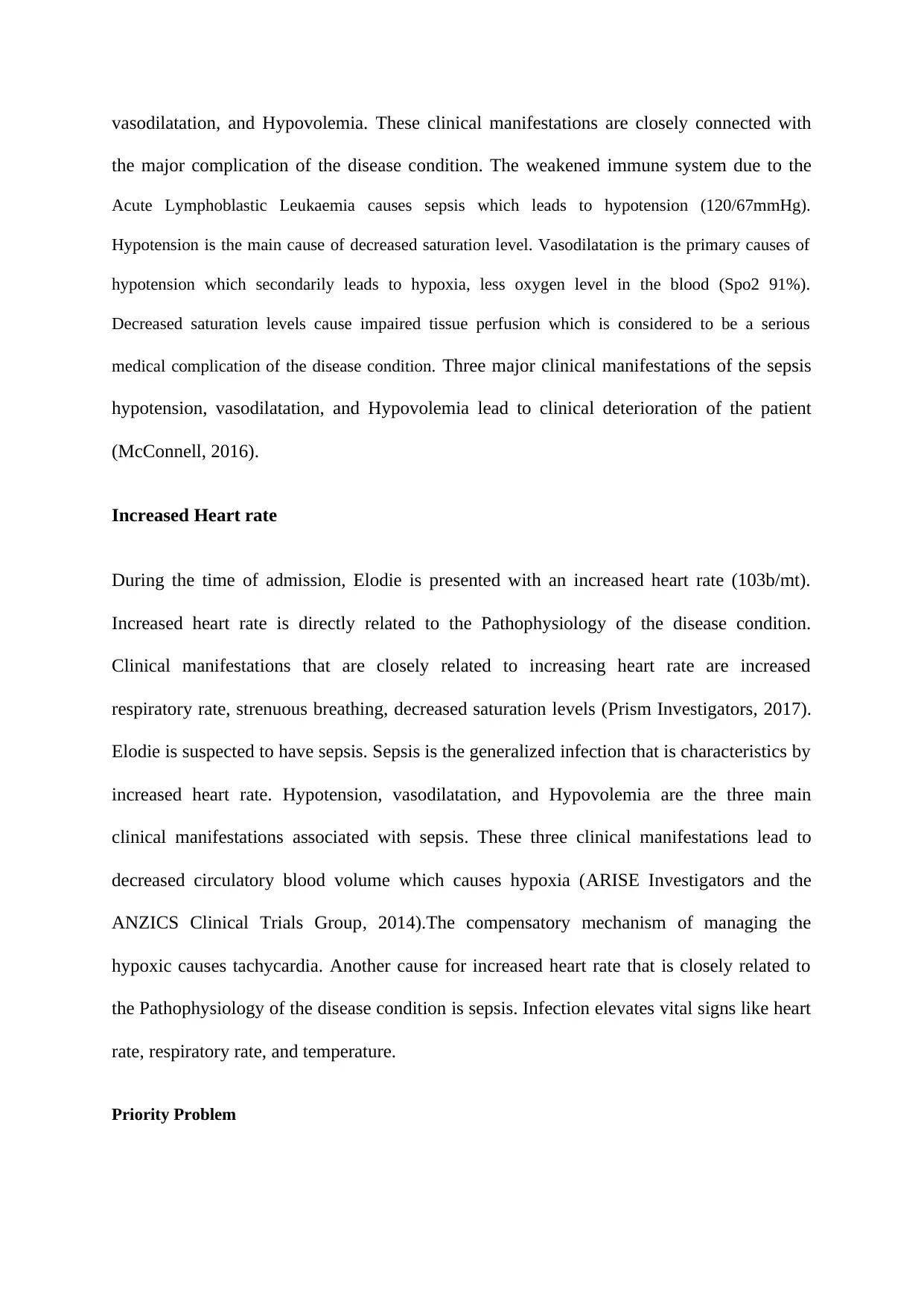
vasodilatation, and Hypovolemia. These clinical manifestations are closely connected with
the major complication of the disease condition. The weakened immune system due to the
Acute Lymphoblastic Leukaemia causes sepsis which leads to hypotension (120/67mmHg).
Hypotension is the main cause of decreased saturation level. Vasodilatation is the primary causes of
hypotension which secondarily leads to hypoxia, less oxygen level in the blood (Spo2 91%).
Decreased saturation levels cause impaired tissue perfusion which is considered to be a serious
medical complication of the disease condition. Three major clinical manifestations of the sepsis
hypotension, vasodilatation, and Hypovolemia lead to clinical deterioration of the patient
(McConnell, 2016).
Increased Heart rate
During the time of admission, Elodie is presented with an increased heart rate (103b/mt).
Increased heart rate is directly related to the Pathophysiology of the disease condition.
Clinical manifestations that are closely related to increasing heart rate are increased
respiratory rate, strenuous breathing, decreased saturation levels (Prism Investigators, 2017).
Elodie is suspected to have sepsis. Sepsis is the generalized infection that is characteristics by
increased heart rate. Hypotension, vasodilatation, and Hypovolemia are the three main
clinical manifestations associated with sepsis. These three clinical manifestations lead to
decreased circulatory blood volume which causes hypoxia (ARISE Investigators and the
ANZICS Clinical Trials Group, 2014).The compensatory mechanism of managing the
hypoxic causes tachycardia. Another cause for increased heart rate that is closely related to
the Pathophysiology of the disease condition is sepsis. Infection elevates vital signs like heart
rate, respiratory rate, and temperature.
Priority Problem
the major complication of the disease condition. The weakened immune system due to the
Acute Lymphoblastic Leukaemia causes sepsis which leads to hypotension (120/67mmHg).
Hypotension is the main cause of decreased saturation level. Vasodilatation is the primary causes of
hypotension which secondarily leads to hypoxia, less oxygen level in the blood (Spo2 91%).
Decreased saturation levels cause impaired tissue perfusion which is considered to be a serious
medical complication of the disease condition. Three major clinical manifestations of the sepsis
hypotension, vasodilatation, and Hypovolemia lead to clinical deterioration of the patient
(McConnell, 2016).
Increased Heart rate
During the time of admission, Elodie is presented with an increased heart rate (103b/mt).
Increased heart rate is directly related to the Pathophysiology of the disease condition.
Clinical manifestations that are closely related to increasing heart rate are increased
respiratory rate, strenuous breathing, decreased saturation levels (Prism Investigators, 2017).
Elodie is suspected to have sepsis. Sepsis is the generalized infection that is characteristics by
increased heart rate. Hypotension, vasodilatation, and Hypovolemia are the three main
clinical manifestations associated with sepsis. These three clinical manifestations lead to
decreased circulatory blood volume which causes hypoxia (ARISE Investigators and the
ANZICS Clinical Trials Group, 2014).The compensatory mechanism of managing the
hypoxic causes tachycardia. Another cause for increased heart rate that is closely related to
the Pathophysiology of the disease condition is sepsis. Infection elevates vital signs like heart
rate, respiratory rate, and temperature.
Priority Problem
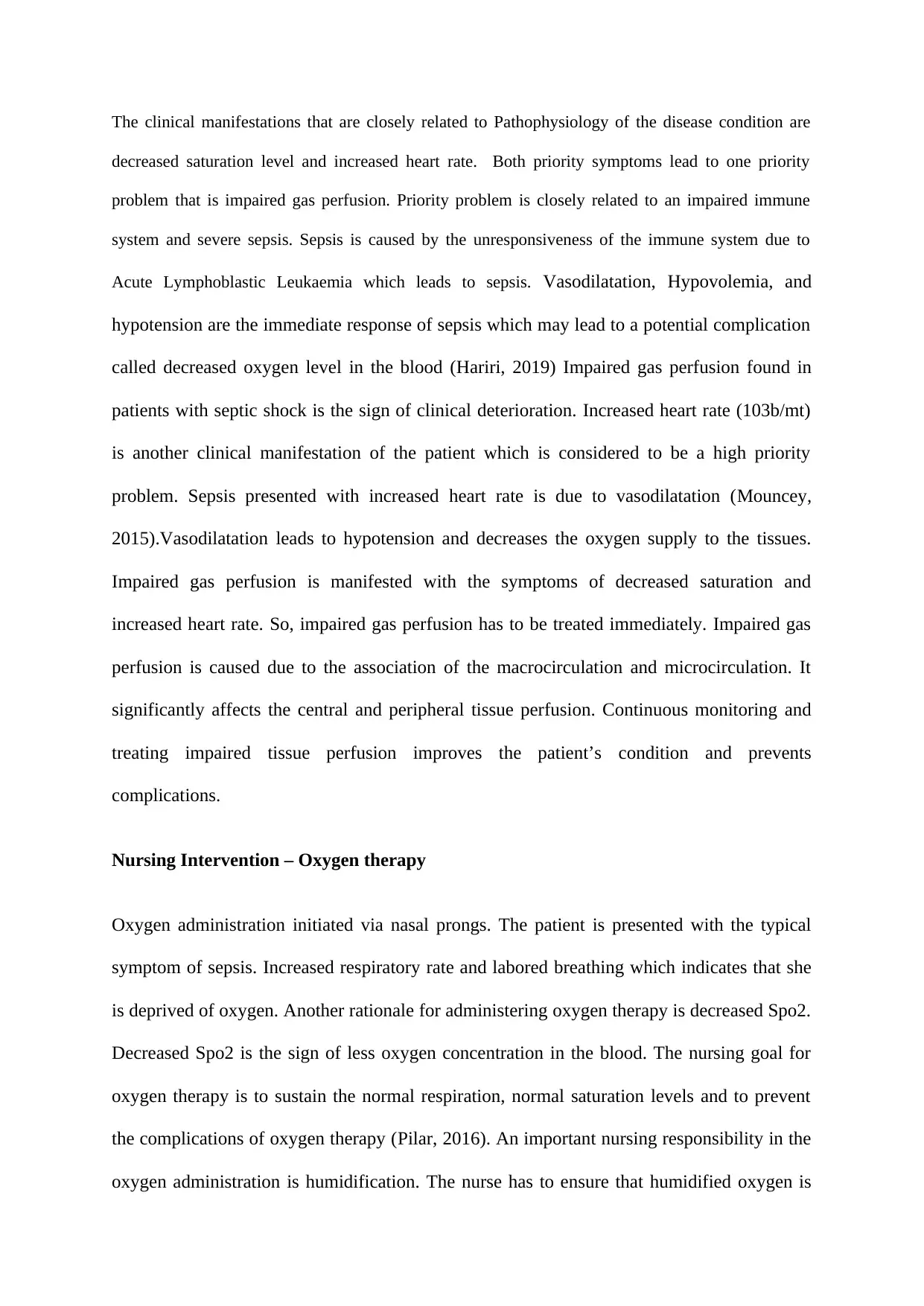
The clinical manifestations that are closely related to Pathophysiology of the disease condition are
decreased saturation level and increased heart rate. Both priority symptoms lead to one priority
problem that is impaired gas perfusion. Priority problem is closely related to an impaired immune
system and severe sepsis. Sepsis is caused by the unresponsiveness of the immune system due to
Acute Lymphoblastic Leukaemia which leads to sepsis. Vasodilatation, Hypovolemia, and
hypotension are the immediate response of sepsis which may lead to a potential complication
called decreased oxygen level in the blood (Hariri, 2019) Impaired gas perfusion found in
patients with septic shock is the sign of clinical deterioration. Increased heart rate (103b/mt)
is another clinical manifestation of the patient which is considered to be a high priority
problem. Sepsis presented with increased heart rate is due to vasodilatation (Mouncey,
2015).Vasodilatation leads to hypotension and decreases the oxygen supply to the tissues.
Impaired gas perfusion is manifested with the symptoms of decreased saturation and
increased heart rate. So, impaired gas perfusion has to be treated immediately. Impaired gas
perfusion is caused due to the association of the macrocirculation and microcirculation. It
significantly affects the central and peripheral tissue perfusion. Continuous monitoring and
treating impaired tissue perfusion improves the patient’s condition and prevents
complications.
Nursing Intervention – Oxygen therapy
Oxygen administration initiated via nasal prongs. The patient is presented with the typical
symptom of sepsis. Increased respiratory rate and labored breathing which indicates that she
is deprived of oxygen. Another rationale for administering oxygen therapy is decreased Spo2.
Decreased Spo2 is the sign of less oxygen concentration in the blood. The nursing goal for
oxygen therapy is to sustain the normal respiration, normal saturation levels and to prevent
the complications of oxygen therapy (Pilar, 2016). An important nursing responsibility in the
oxygen administration is humidification. The nurse has to ensure that humidified oxygen is
decreased saturation level and increased heart rate. Both priority symptoms lead to one priority
problem that is impaired gas perfusion. Priority problem is closely related to an impaired immune
system and severe sepsis. Sepsis is caused by the unresponsiveness of the immune system due to
Acute Lymphoblastic Leukaemia which leads to sepsis. Vasodilatation, Hypovolemia, and
hypotension are the immediate response of sepsis which may lead to a potential complication
called decreased oxygen level in the blood (Hariri, 2019) Impaired gas perfusion found in
patients with septic shock is the sign of clinical deterioration. Increased heart rate (103b/mt)
is another clinical manifestation of the patient which is considered to be a high priority
problem. Sepsis presented with increased heart rate is due to vasodilatation (Mouncey,
2015).Vasodilatation leads to hypotension and decreases the oxygen supply to the tissues.
Impaired gas perfusion is manifested with the symptoms of decreased saturation and
increased heart rate. So, impaired gas perfusion has to be treated immediately. Impaired gas
perfusion is caused due to the association of the macrocirculation and microcirculation. It
significantly affects the central and peripheral tissue perfusion. Continuous monitoring and
treating impaired tissue perfusion improves the patient’s condition and prevents
complications.
Nursing Intervention – Oxygen therapy
Oxygen administration initiated via nasal prongs. The patient is presented with the typical
symptom of sepsis. Increased respiratory rate and labored breathing which indicates that she
is deprived of oxygen. Another rationale for administering oxygen therapy is decreased Spo2.
Decreased Spo2 is the sign of less oxygen concentration in the blood. The nursing goal for
oxygen therapy is to sustain the normal respiration, normal saturation levels and to prevent
the complications of oxygen therapy (Pilar, 2016). An important nursing responsibility in the
oxygen administration is humidification. The nurse has to ensure that humidified oxygen is
⊘ This is a preview!⊘
Do you want full access?
Subscribe today to unlock all pages.

Trusted by 1+ million students worldwide
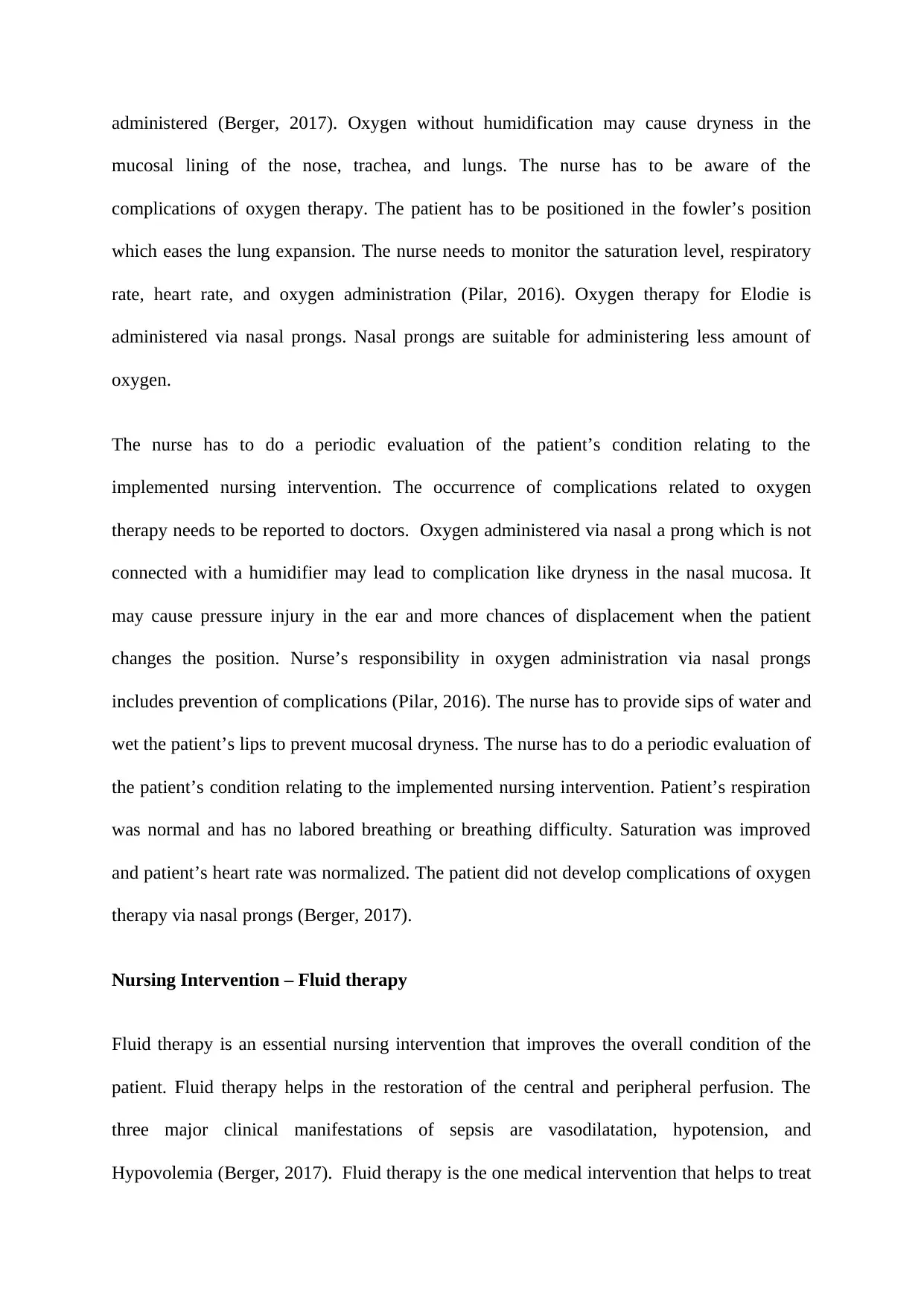
administered (Berger, 2017). Oxygen without humidification may cause dryness in the
mucosal lining of the nose, trachea, and lungs. The nurse has to be aware of the
complications of oxygen therapy. The patient has to be positioned in the fowler’s position
which eases the lung expansion. The nurse needs to monitor the saturation level, respiratory
rate, heart rate, and oxygen administration (Pilar, 2016). Oxygen therapy for Elodie is
administered via nasal prongs. Nasal prongs are suitable for administering less amount of
oxygen.
The nurse has to do a periodic evaluation of the patient’s condition relating to the
implemented nursing intervention. The occurrence of complications related to oxygen
therapy needs to be reported to doctors. Oxygen administered via nasal a prong which is not
connected with a humidifier may lead to complication like dryness in the nasal mucosa. It
may cause pressure injury in the ear and more chances of displacement when the patient
changes the position. Nurse’s responsibility in oxygen administration via nasal prongs
includes prevention of complications (Pilar, 2016). The nurse has to provide sips of water and
wet the patient’s lips to prevent mucosal dryness. The nurse has to do a periodic evaluation of
the patient’s condition relating to the implemented nursing intervention. Patient’s respiration
was normal and has no labored breathing or breathing difficulty. Saturation was improved
and patient’s heart rate was normalized. The patient did not develop complications of oxygen
therapy via nasal prongs (Berger, 2017).
Nursing Intervention – Fluid therapy
Fluid therapy is an essential nursing intervention that improves the overall condition of the
patient. Fluid therapy helps in the restoration of the central and peripheral perfusion. The
three major clinical manifestations of sepsis are vasodilatation, hypotension, and
Hypovolemia (Berger, 2017). Fluid therapy is the one medical intervention that helps to treat
mucosal lining of the nose, trachea, and lungs. The nurse has to be aware of the
complications of oxygen therapy. The patient has to be positioned in the fowler’s position
which eases the lung expansion. The nurse needs to monitor the saturation level, respiratory
rate, heart rate, and oxygen administration (Pilar, 2016). Oxygen therapy for Elodie is
administered via nasal prongs. Nasal prongs are suitable for administering less amount of
oxygen.
The nurse has to do a periodic evaluation of the patient’s condition relating to the
implemented nursing intervention. The occurrence of complications related to oxygen
therapy needs to be reported to doctors. Oxygen administered via nasal a prong which is not
connected with a humidifier may lead to complication like dryness in the nasal mucosa. It
may cause pressure injury in the ear and more chances of displacement when the patient
changes the position. Nurse’s responsibility in oxygen administration via nasal prongs
includes prevention of complications (Pilar, 2016). The nurse has to provide sips of water and
wet the patient’s lips to prevent mucosal dryness. The nurse has to do a periodic evaluation of
the patient’s condition relating to the implemented nursing intervention. Patient’s respiration
was normal and has no labored breathing or breathing difficulty. Saturation was improved
and patient’s heart rate was normalized. The patient did not develop complications of oxygen
therapy via nasal prongs (Berger, 2017).
Nursing Intervention – Fluid therapy
Fluid therapy is an essential nursing intervention that improves the overall condition of the
patient. Fluid therapy helps in the restoration of the central and peripheral perfusion. The
three major clinical manifestations of sepsis are vasodilatation, hypotension, and
Hypovolemia (Berger, 2017). Fluid therapy is the one medical intervention that helps to treat
Paraphrase This Document
Need a fresh take? Get an instant paraphrase of this document with our AI Paraphraser
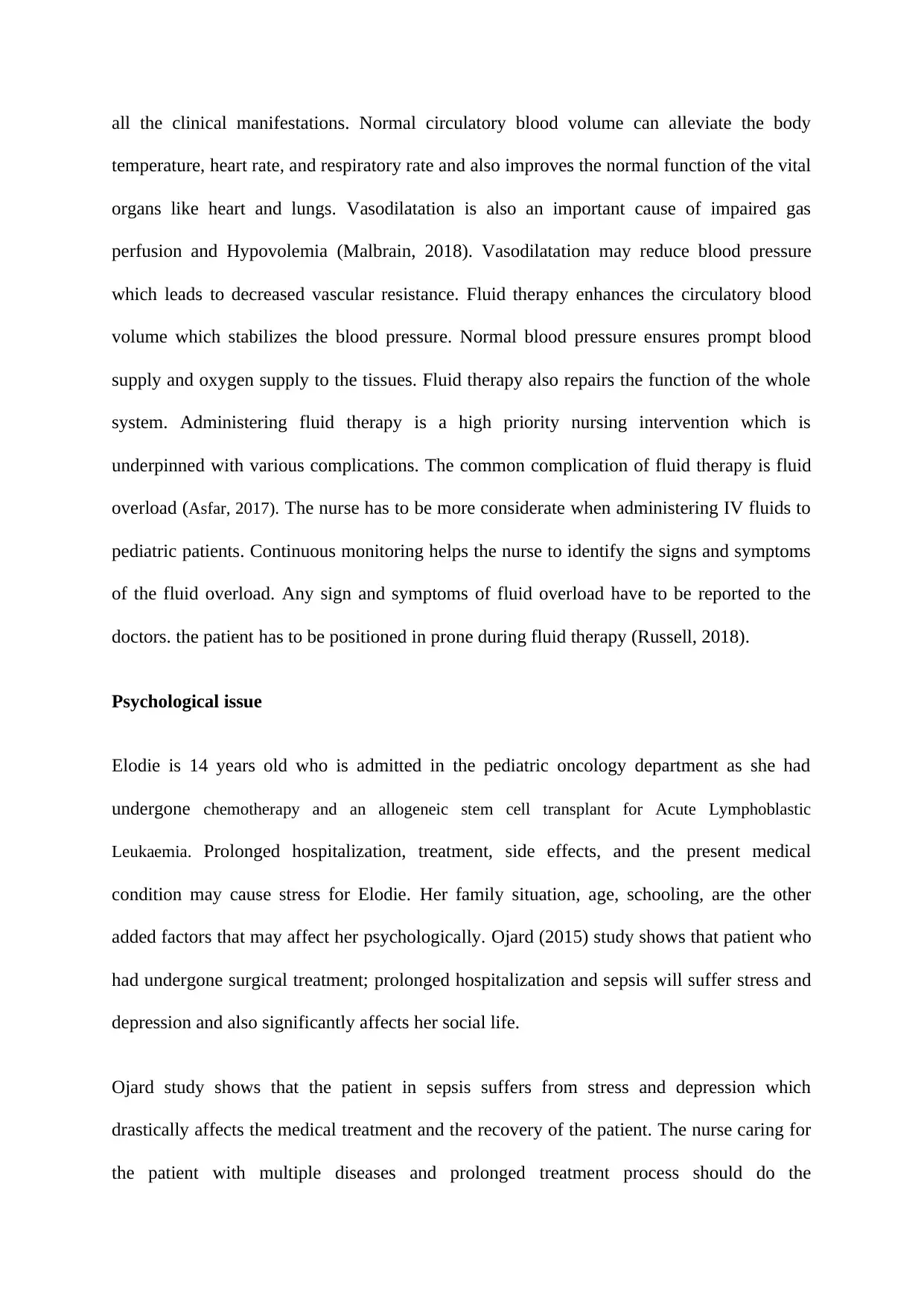
all the clinical manifestations. Normal circulatory blood volume can alleviate the body
temperature, heart rate, and respiratory rate and also improves the normal function of the vital
organs like heart and lungs. Vasodilatation is also an important cause of impaired gas
perfusion and Hypovolemia (Malbrain, 2018). Vasodilatation may reduce blood pressure
which leads to decreased vascular resistance. Fluid therapy enhances the circulatory blood
volume which stabilizes the blood pressure. Normal blood pressure ensures prompt blood
supply and oxygen supply to the tissues. Fluid therapy also repairs the function of the whole
system. Administering fluid therapy is a high priority nursing intervention which is
underpinned with various complications. The common complication of fluid therapy is fluid
overload (Asfar, 2017). The nurse has to be more considerate when administering IV fluids to
pediatric patients. Continuous monitoring helps the nurse to identify the signs and symptoms
of the fluid overload. Any sign and symptoms of fluid overload have to be reported to the
doctors. the patient has to be positioned in prone during fluid therapy (Russell, 2018).
Psychological issue
Elodie is 14 years old who is admitted in the pediatric oncology department as she had
undergone chemotherapy and an allogeneic stem cell transplant for Acute Lymphoblastic
Leukaemia. Prolonged hospitalization, treatment, side effects, and the present medical
condition may cause stress for Elodie. Her family situation, age, schooling, are the other
added factors that may affect her psychologically. Ojard (2015) study shows that patient who
had undergone surgical treatment; prolonged hospitalization and sepsis will suffer stress and
depression and also significantly affects her social life.
Ojard study shows that the patient in sepsis suffers from stress and depression which
drastically affects the medical treatment and the recovery of the patient. The nurse caring for
the patient with multiple diseases and prolonged treatment process should do the
temperature, heart rate, and respiratory rate and also improves the normal function of the vital
organs like heart and lungs. Vasodilatation is also an important cause of impaired gas
perfusion and Hypovolemia (Malbrain, 2018). Vasodilatation may reduce blood pressure
which leads to decreased vascular resistance. Fluid therapy enhances the circulatory blood
volume which stabilizes the blood pressure. Normal blood pressure ensures prompt blood
supply and oxygen supply to the tissues. Fluid therapy also repairs the function of the whole
system. Administering fluid therapy is a high priority nursing intervention which is
underpinned with various complications. The common complication of fluid therapy is fluid
overload (Asfar, 2017). The nurse has to be more considerate when administering IV fluids to
pediatric patients. Continuous monitoring helps the nurse to identify the signs and symptoms
of the fluid overload. Any sign and symptoms of fluid overload have to be reported to the
doctors. the patient has to be positioned in prone during fluid therapy (Russell, 2018).
Psychological issue
Elodie is 14 years old who is admitted in the pediatric oncology department as she had
undergone chemotherapy and an allogeneic stem cell transplant for Acute Lymphoblastic
Leukaemia. Prolonged hospitalization, treatment, side effects, and the present medical
condition may cause stress for Elodie. Her family situation, age, schooling, are the other
added factors that may affect her psychologically. Ojard (2015) study shows that patient who
had undergone surgical treatment; prolonged hospitalization and sepsis will suffer stress and
depression and also significantly affects her social life.
Ojard study shows that the patient in sepsis suffers from stress and depression which
drastically affects the medical treatment and the recovery of the patient. The nurse caring for
the patient with multiple diseases and prolonged treatment process should do the
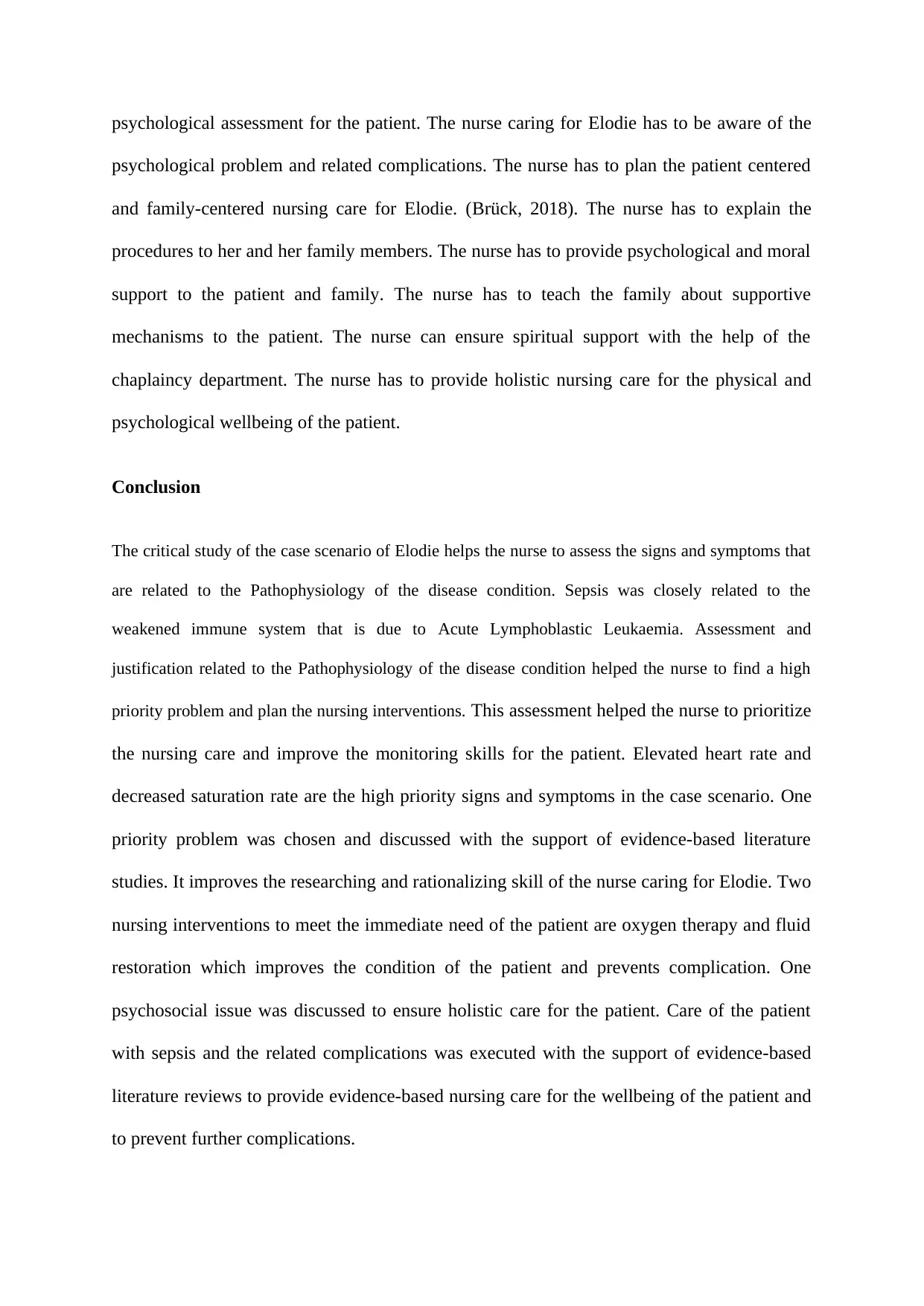
psychological assessment for the patient. The nurse caring for Elodie has to be aware of the
psychological problem and related complications. The nurse has to plan the patient centered
and family-centered nursing care for Elodie. (Brück, 2018). The nurse has to explain the
procedures to her and her family members. The nurse has to provide psychological and moral
support to the patient and family. The nurse has to teach the family about supportive
mechanisms to the patient. The nurse can ensure spiritual support with the help of the
chaplaincy department. The nurse has to provide holistic nursing care for the physical and
psychological wellbeing of the patient.
Conclusion
The critical study of the case scenario of Elodie helps the nurse to assess the signs and symptoms that
are related to the Pathophysiology of the disease condition. Sepsis was closely related to the
weakened immune system that is due to Acute Lymphoblastic Leukaemia. Assessment and
justification related to the Pathophysiology of the disease condition helped the nurse to find a high
priority problem and plan the nursing interventions. This assessment helped the nurse to prioritize
the nursing care and improve the monitoring skills for the patient. Elevated heart rate and
decreased saturation rate are the high priority signs and symptoms in the case scenario. One
priority problem was chosen and discussed with the support of evidence-based literature
studies. It improves the researching and rationalizing skill of the nurse caring for Elodie. Two
nursing interventions to meet the immediate need of the patient are oxygen therapy and fluid
restoration which improves the condition of the patient and prevents complication. One
psychosocial issue was discussed to ensure holistic care for the patient. Care of the patient
with sepsis and the related complications was executed with the support of evidence-based
literature reviews to provide evidence-based nursing care for the wellbeing of the patient and
to prevent further complications.
psychological problem and related complications. The nurse has to plan the patient centered
and family-centered nursing care for Elodie. (Brück, 2018). The nurse has to explain the
procedures to her and her family members. The nurse has to provide psychological and moral
support to the patient and family. The nurse has to teach the family about supportive
mechanisms to the patient. The nurse can ensure spiritual support with the help of the
chaplaincy department. The nurse has to provide holistic nursing care for the physical and
psychological wellbeing of the patient.
Conclusion
The critical study of the case scenario of Elodie helps the nurse to assess the signs and symptoms that
are related to the Pathophysiology of the disease condition. Sepsis was closely related to the
weakened immune system that is due to Acute Lymphoblastic Leukaemia. Assessment and
justification related to the Pathophysiology of the disease condition helped the nurse to find a high
priority problem and plan the nursing interventions. This assessment helped the nurse to prioritize
the nursing care and improve the monitoring skills for the patient. Elevated heart rate and
decreased saturation rate are the high priority signs and symptoms in the case scenario. One
priority problem was chosen and discussed with the support of evidence-based literature
studies. It improves the researching and rationalizing skill of the nurse caring for Elodie. Two
nursing interventions to meet the immediate need of the patient are oxygen therapy and fluid
restoration which improves the condition of the patient and prevents complication. One
psychosocial issue was discussed to ensure holistic care for the patient. Care of the patient
with sepsis and the related complications was executed with the support of evidence-based
literature reviews to provide evidence-based nursing care for the wellbeing of the patient and
to prevent further complications.
⊘ This is a preview!⊘
Do you want full access?
Subscribe today to unlock all pages.

Trusted by 1+ million students worldwide
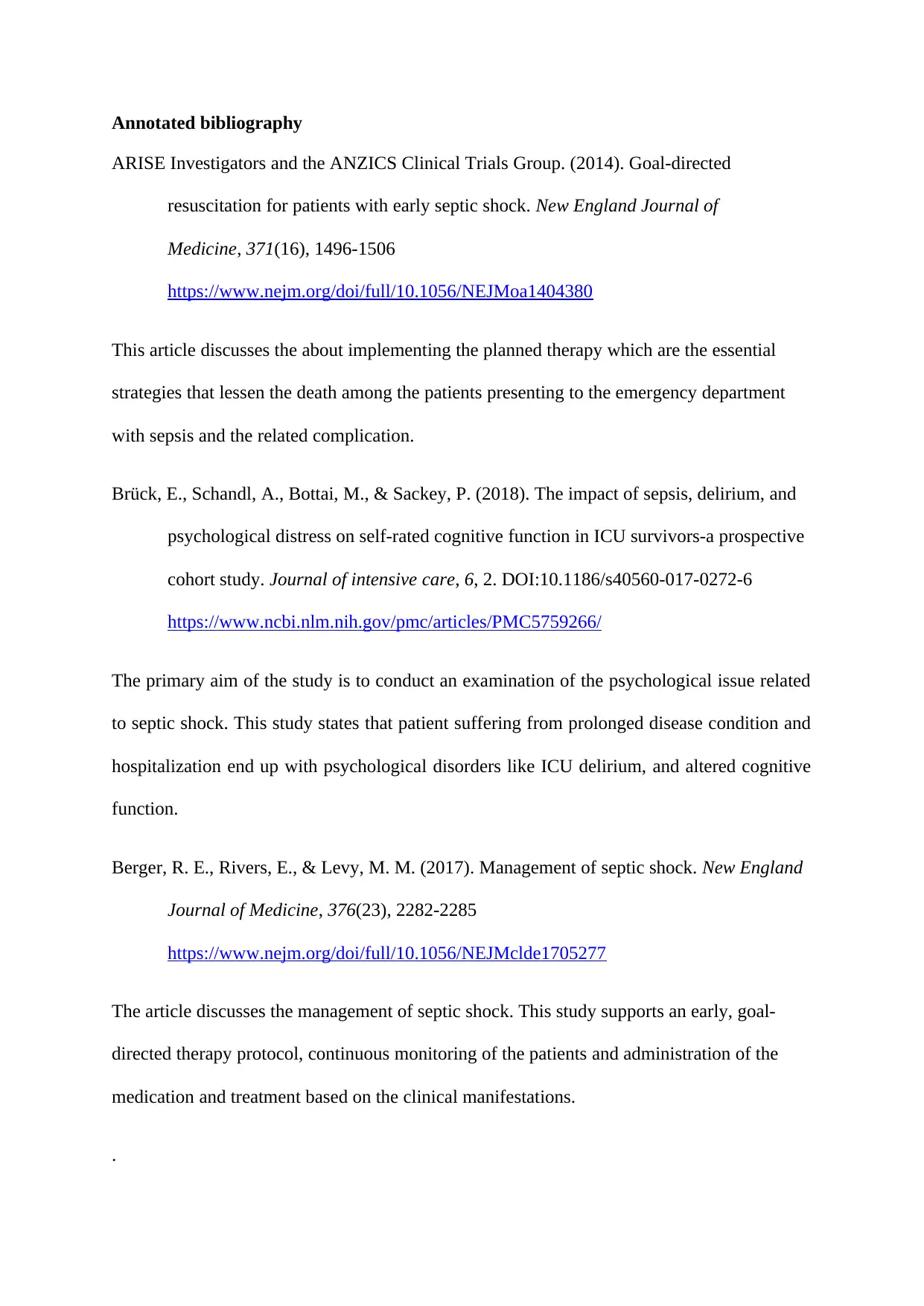
Annotated bibliography
ARISE Investigators and the ANZICS Clinical Trials Group. (2014). Goal-directed
resuscitation for patients with early septic shock. New England Journal of
Medicine, 371(16), 1496-1506
https://www.nejm.org/doi/full/10.1056/NEJMoa1404380
This article discusses the about implementing the planned therapy which are the essential
strategies that lessen the death among the patients presenting to the emergency department
with sepsis and the related complication.
Brück, E., Schandl, A., Bottai, M., & Sackey, P. (2018). The impact of sepsis, delirium, and
psychological distress on self-rated cognitive function in ICU survivors-a prospective
cohort study. Journal of intensive care, 6, 2. DOI:10.1186/s40560-017-0272-6
https://www.ncbi.nlm.nih.gov/pmc/articles/PMC5759266/
The primary aim of the study is to conduct an examination of the psychological issue related
to septic shock. This study states that patient suffering from prolonged disease condition and
hospitalization end up with psychological disorders like ICU delirium, and altered cognitive
function.
Berger, R. E., Rivers, E., & Levy, M. M. (2017). Management of septic shock. New England
Journal of Medicine, 376(23), 2282-2285
https://www.nejm.org/doi/full/10.1056/NEJMclde1705277
The article discusses the management of septic shock. This study supports an early, goal-
directed therapy protocol, continuous monitoring of the patients and administration of the
medication and treatment based on the clinical manifestations.
.
ARISE Investigators and the ANZICS Clinical Trials Group. (2014). Goal-directed
resuscitation for patients with early septic shock. New England Journal of
Medicine, 371(16), 1496-1506
https://www.nejm.org/doi/full/10.1056/NEJMoa1404380
This article discusses the about implementing the planned therapy which are the essential
strategies that lessen the death among the patients presenting to the emergency department
with sepsis and the related complication.
Brück, E., Schandl, A., Bottai, M., & Sackey, P. (2018). The impact of sepsis, delirium, and
psychological distress on self-rated cognitive function in ICU survivors-a prospective
cohort study. Journal of intensive care, 6, 2. DOI:10.1186/s40560-017-0272-6
https://www.ncbi.nlm.nih.gov/pmc/articles/PMC5759266/
The primary aim of the study is to conduct an examination of the psychological issue related
to septic shock. This study states that patient suffering from prolonged disease condition and
hospitalization end up with psychological disorders like ICU delirium, and altered cognitive
function.
Berger, R. E., Rivers, E., & Levy, M. M. (2017). Management of septic shock. New England
Journal of Medicine, 376(23), 2282-2285
https://www.nejm.org/doi/full/10.1056/NEJMclde1705277
The article discusses the management of septic shock. This study supports an early, goal-
directed therapy protocol, continuous monitoring of the patients and administration of the
medication and treatment based on the clinical manifestations.
.
Paraphrase This Document
Need a fresh take? Get an instant paraphrase of this document with our AI Paraphraser
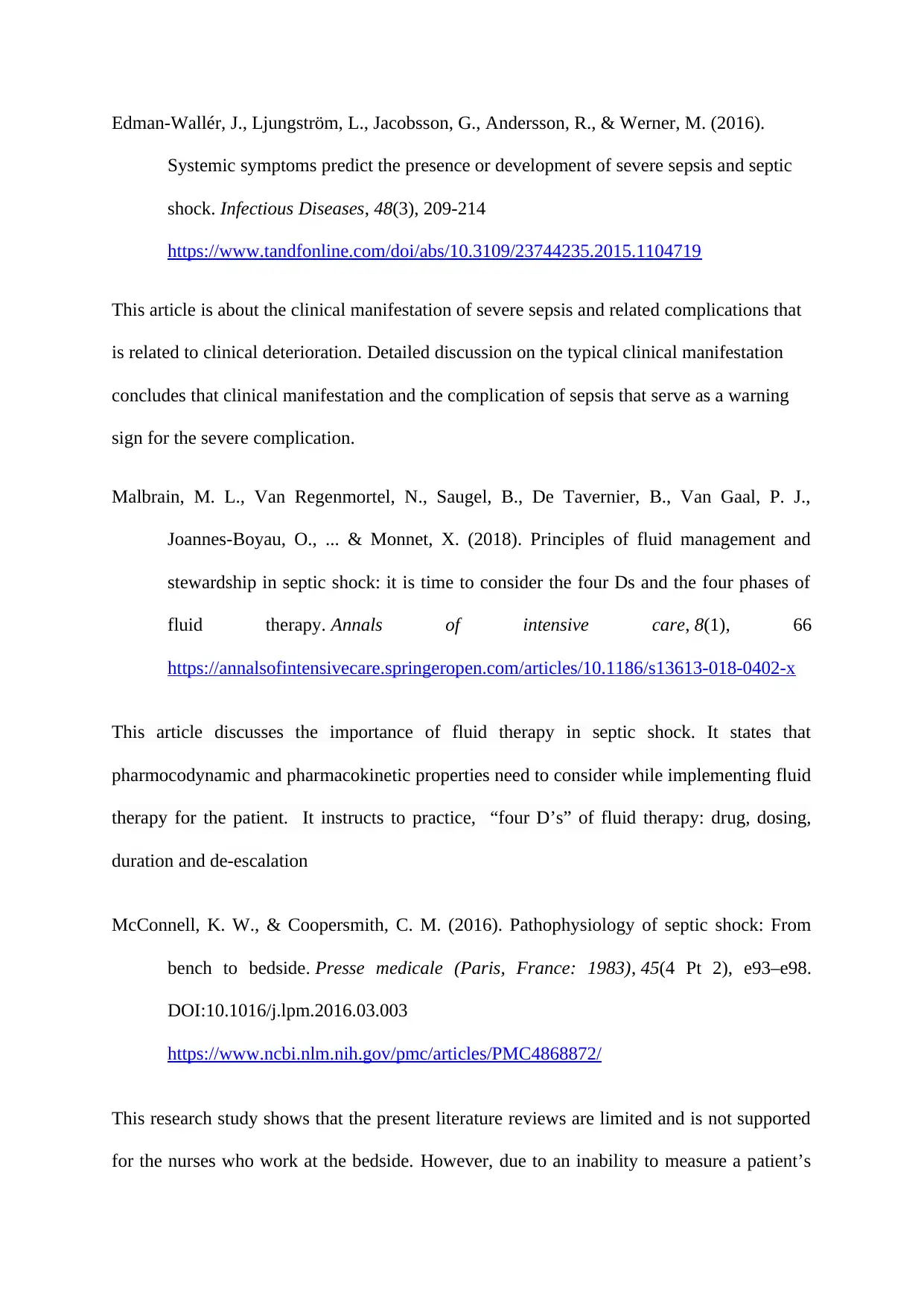
Edman-Wallér, J., Ljungström, L., Jacobsson, G., Andersson, R., & Werner, M. (2016).
Systemic symptoms predict the presence or development of severe sepsis and septic
shock. Infectious Diseases, 48(3), 209-214
https://www.tandfonline.com/doi/abs/10.3109/23744235.2015.1104719
This article is about the clinical manifestation of severe sepsis and related complications that
is related to clinical deterioration. Detailed discussion on the typical clinical manifestation
concludes that clinical manifestation and the complication of sepsis that serve as a warning
sign for the severe complication.
Malbrain, M. L., Van Regenmortel, N., Saugel, B., De Tavernier, B., Van Gaal, P. J.,
Joannes-Boyau, O., ... & Monnet, X. (2018). Principles of fluid management and
stewardship in septic shock: it is time to consider the four Ds and the four phases of
fluid therapy. Annals of intensive care, 8(1), 66
https://annalsofintensivecare.springeropen.com/articles/10.1186/s13613-018-0402-x
This article discusses the importance of fluid therapy in septic shock. It states that
pharmocodynamic and pharmacokinetic properties need to consider while implementing fluid
therapy for the patient. It instructs to practice, “four D’s” of fluid therapy: drug, dosing,
duration and de-escalation
McConnell, K. W., & Coopersmith, C. M. (2016). Pathophysiology of septic shock: From
bench to bedside. Presse medicale (Paris, France: 1983), 45(4 Pt 2), e93–e98.
DOI:10.1016/j.lpm.2016.03.003
https://www.ncbi.nlm.nih.gov/pmc/articles/PMC4868872/
This research study shows that the present literature reviews are limited and is not supported
for the nurses who work at the bedside. However, due to an inability to measure a patient’s
Systemic symptoms predict the presence or development of severe sepsis and septic
shock. Infectious Diseases, 48(3), 209-214
https://www.tandfonline.com/doi/abs/10.3109/23744235.2015.1104719
This article is about the clinical manifestation of severe sepsis and related complications that
is related to clinical deterioration. Detailed discussion on the typical clinical manifestation
concludes that clinical manifestation and the complication of sepsis that serve as a warning
sign for the severe complication.
Malbrain, M. L., Van Regenmortel, N., Saugel, B., De Tavernier, B., Van Gaal, P. J.,
Joannes-Boyau, O., ... & Monnet, X. (2018). Principles of fluid management and
stewardship in septic shock: it is time to consider the four Ds and the four phases of
fluid therapy. Annals of intensive care, 8(1), 66
https://annalsofintensivecare.springeropen.com/articles/10.1186/s13613-018-0402-x
This article discusses the importance of fluid therapy in septic shock. It states that
pharmocodynamic and pharmacokinetic properties need to consider while implementing fluid
therapy for the patient. It instructs to practice, “four D’s” of fluid therapy: drug, dosing,
duration and de-escalation
McConnell, K. W., & Coopersmith, C. M. (2016). Pathophysiology of septic shock: From
bench to bedside. Presse medicale (Paris, France: 1983), 45(4 Pt 2), e93–e98.
DOI:10.1016/j.lpm.2016.03.003
https://www.ncbi.nlm.nih.gov/pmc/articles/PMC4868872/
This research study shows that the present literature reviews are limited and is not supported
for the nurses who work at the bedside. However, due to an inability to measure a patient’s
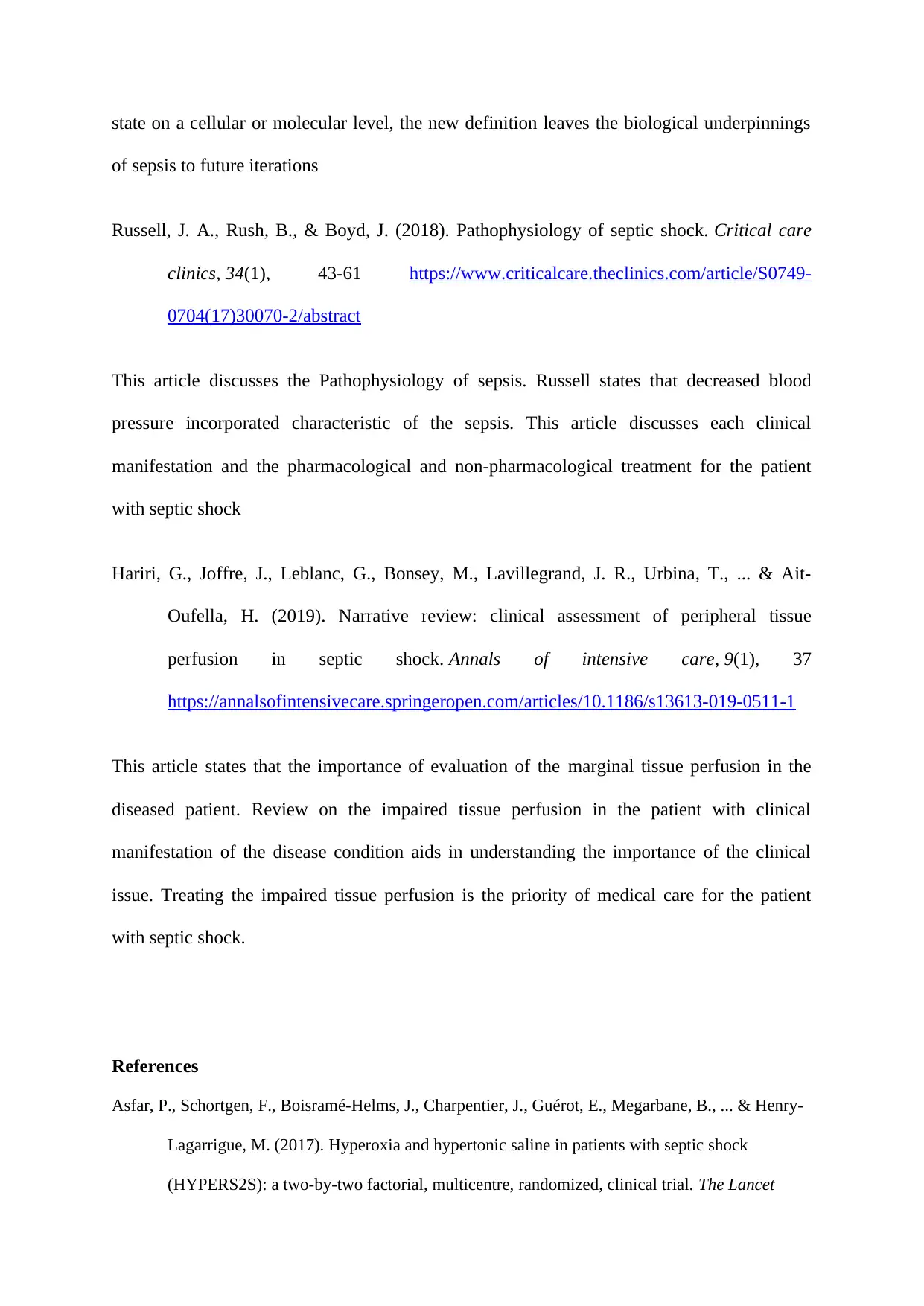
state on a cellular or molecular level, the new definition leaves the biological underpinnings
of sepsis to future iterations
Russell, J. A., Rush, B., & Boyd, J. (2018). Pathophysiology of septic shock. Critical care
clinics, 34(1), 43-61 https://www.criticalcare.theclinics.com/article/S0749-
0704(17)30070-2/abstract
This article discusses the Pathophysiology of sepsis. Russell states that decreased blood
pressure incorporated characteristic of the sepsis. This article discusses each clinical
manifestation and the pharmacological and non-pharmacological treatment for the patient
with septic shock
Hariri, G., Joffre, J., Leblanc, G., Bonsey, M., Lavillegrand, J. R., Urbina, T., ... & Ait-
Oufella, H. (2019). Narrative review: clinical assessment of peripheral tissue
perfusion in septic shock. Annals of intensive care, 9(1), 37
https://annalsofintensivecare.springeropen.com/articles/10.1186/s13613-019-0511-1
This article states that the importance of evaluation of the marginal tissue perfusion in the
diseased patient. Review on the impaired tissue perfusion in the patient with clinical
manifestation of the disease condition aids in understanding the importance of the clinical
issue. Treating the impaired tissue perfusion is the priority of medical care for the patient
with septic shock.
References
Asfar, P., Schortgen, F., Boisramé-Helms, J., Charpentier, J., Guérot, E., Megarbane, B., ... & Henry-
Lagarrigue, M. (2017). Hyperoxia and hypertonic saline in patients with septic shock
(HYPERS2S): a two-by-two factorial, multicentre, randomized, clinical trial. The Lancet
of sepsis to future iterations
Russell, J. A., Rush, B., & Boyd, J. (2018). Pathophysiology of septic shock. Critical care
clinics, 34(1), 43-61 https://www.criticalcare.theclinics.com/article/S0749-
0704(17)30070-2/abstract
This article discusses the Pathophysiology of sepsis. Russell states that decreased blood
pressure incorporated characteristic of the sepsis. This article discusses each clinical
manifestation and the pharmacological and non-pharmacological treatment for the patient
with septic shock
Hariri, G., Joffre, J., Leblanc, G., Bonsey, M., Lavillegrand, J. R., Urbina, T., ... & Ait-
Oufella, H. (2019). Narrative review: clinical assessment of peripheral tissue
perfusion in septic shock. Annals of intensive care, 9(1), 37
https://annalsofintensivecare.springeropen.com/articles/10.1186/s13613-019-0511-1
This article states that the importance of evaluation of the marginal tissue perfusion in the
diseased patient. Review on the impaired tissue perfusion in the patient with clinical
manifestation of the disease condition aids in understanding the importance of the clinical
issue. Treating the impaired tissue perfusion is the priority of medical care for the patient
with septic shock.
References
Asfar, P., Schortgen, F., Boisramé-Helms, J., Charpentier, J., Guérot, E., Megarbane, B., ... & Henry-
Lagarrigue, M. (2017). Hyperoxia and hypertonic saline in patients with septic shock
(HYPERS2S): a two-by-two factorial, multicentre, randomized, clinical trial. The Lancet
⊘ This is a preview!⊘
Do you want full access?
Subscribe today to unlock all pages.

Trusted by 1+ million students worldwide
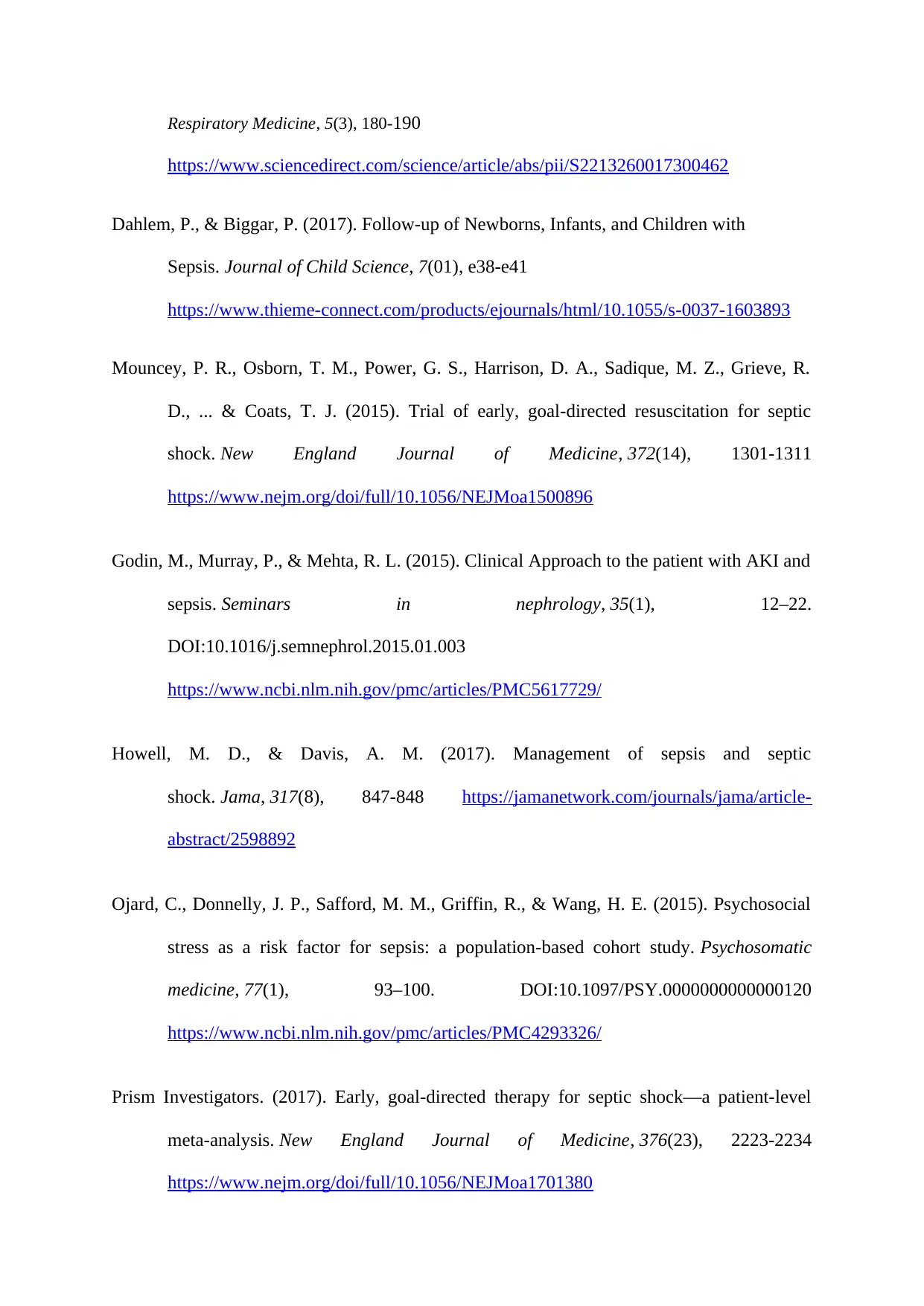
Respiratory Medicine, 5(3), 180-190
https://www.sciencedirect.com/science/article/abs/pii/S2213260017300462
Dahlem, P., & Biggar, P. (2017). Follow-up of Newborns, Infants, and Children with
Sepsis. Journal of Child Science, 7(01), e38-e41
https://www.thieme-connect.com/products/ejournals/html/10.1055/s-0037-1603893
Mouncey, P. R., Osborn, T. M., Power, G. S., Harrison, D. A., Sadique, M. Z., Grieve, R.
D., ... & Coats, T. J. (2015). Trial of early, goal-directed resuscitation for septic
shock. New England Journal of Medicine, 372(14), 1301-1311
https://www.nejm.org/doi/full/10.1056/NEJMoa1500896
Godin, M., Murray, P., & Mehta, R. L. (2015). Clinical Approach to the patient with AKI and
sepsis. Seminars in nephrology, 35(1), 12–22.
DOI:10.1016/j.semnephrol.2015.01.003
https://www.ncbi.nlm.nih.gov/pmc/articles/PMC5617729/
Howell, M. D., & Davis, A. M. (2017). Management of sepsis and septic
shock. Jama, 317(8), 847-848 https://jamanetwork.com/journals/jama/article-
abstract/2598892
Ojard, C., Donnelly, J. P., Safford, M. M., Griffin, R., & Wang, H. E. (2015). Psychosocial
stress as a risk factor for sepsis: a population-based cohort study. Psychosomatic
medicine, 77(1), 93–100. DOI:10.1097/PSY.0000000000000120
https://www.ncbi.nlm.nih.gov/pmc/articles/PMC4293326/
Prism Investigators. (2017). Early, goal-directed therapy for septic shock—a patient-level
meta-analysis. New England Journal of Medicine, 376(23), 2223-2234
https://www.nejm.org/doi/full/10.1056/NEJMoa1701380
https://www.sciencedirect.com/science/article/abs/pii/S2213260017300462
Dahlem, P., & Biggar, P. (2017). Follow-up of Newborns, Infants, and Children with
Sepsis. Journal of Child Science, 7(01), e38-e41
https://www.thieme-connect.com/products/ejournals/html/10.1055/s-0037-1603893
Mouncey, P. R., Osborn, T. M., Power, G. S., Harrison, D. A., Sadique, M. Z., Grieve, R.
D., ... & Coats, T. J. (2015). Trial of early, goal-directed resuscitation for septic
shock. New England Journal of Medicine, 372(14), 1301-1311
https://www.nejm.org/doi/full/10.1056/NEJMoa1500896
Godin, M., Murray, P., & Mehta, R. L. (2015). Clinical Approach to the patient with AKI and
sepsis. Seminars in nephrology, 35(1), 12–22.
DOI:10.1016/j.semnephrol.2015.01.003
https://www.ncbi.nlm.nih.gov/pmc/articles/PMC5617729/
Howell, M. D., & Davis, A. M. (2017). Management of sepsis and septic
shock. Jama, 317(8), 847-848 https://jamanetwork.com/journals/jama/article-
abstract/2598892
Ojard, C., Donnelly, J. P., Safford, M. M., Griffin, R., & Wang, H. E. (2015). Psychosocial
stress as a risk factor for sepsis: a population-based cohort study. Psychosomatic
medicine, 77(1), 93–100. DOI:10.1097/PSY.0000000000000120
https://www.ncbi.nlm.nih.gov/pmc/articles/PMC4293326/
Prism Investigators. (2017). Early, goal-directed therapy for septic shock—a patient-level
meta-analysis. New England Journal of Medicine, 376(23), 2223-2234
https://www.nejm.org/doi/full/10.1056/NEJMoa1701380
Paraphrase This Document
Need a fresh take? Get an instant paraphrase of this document with our AI Paraphraser

1 out of 11
Related Documents
Your All-in-One AI-Powered Toolkit for Academic Success.
+13062052269
info@desklib.com
Available 24*7 on WhatsApp / Email
![[object Object]](/_next/static/media/star-bottom.7253800d.svg)
Unlock your academic potential
Copyright © 2020–2025 A2Z Services. All Rights Reserved. Developed and managed by ZUCOL.





